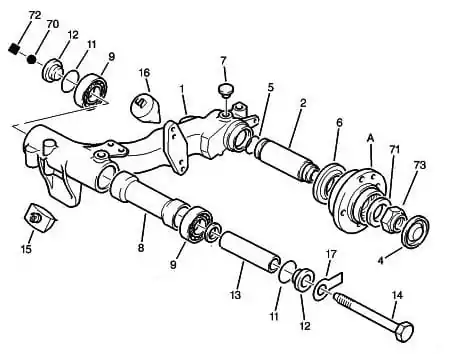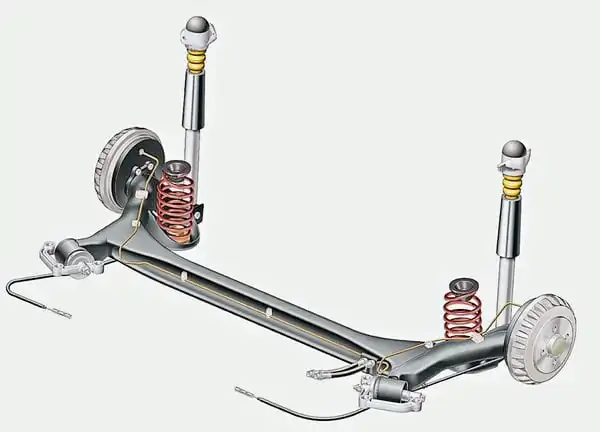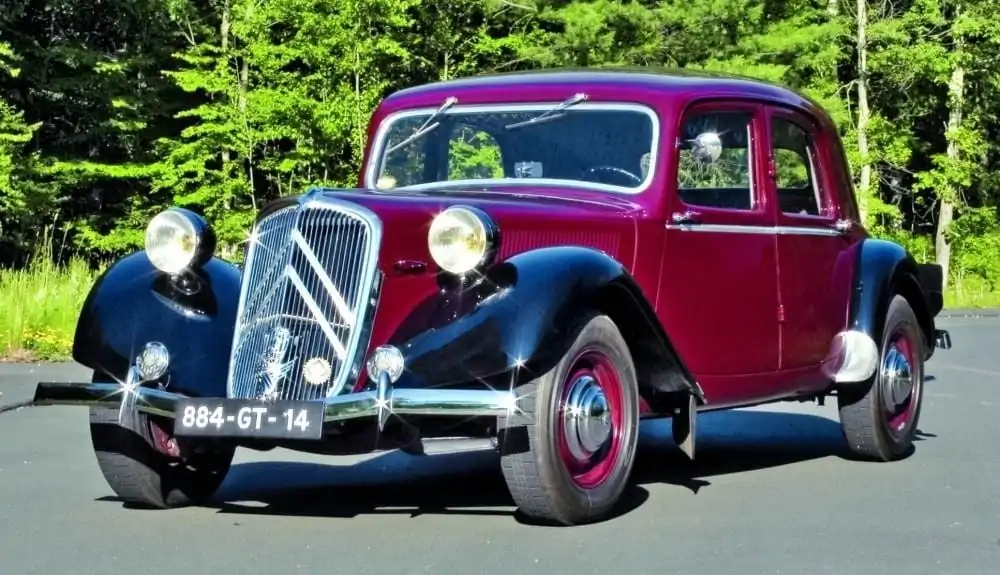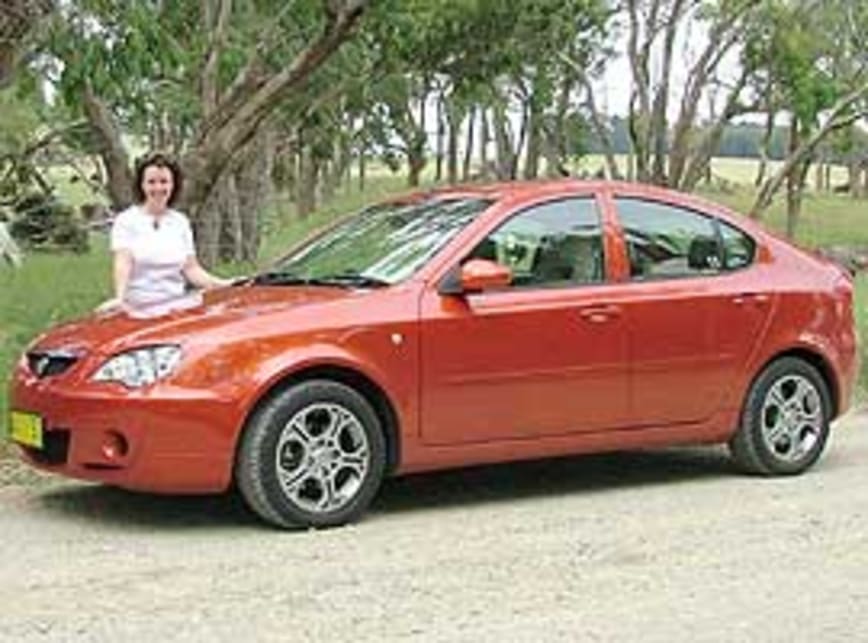
What is a car torsion bar suspension?
Content
Among the types of suspension systems used in modern cars, there is a torsion bar, and now we will try to introduce you to it a little more.
What is a torsion bar?
The simplest explanation we can give is that it is a suspension in which a torsion beam is used as an elastic element that works under the action of torsion in only one direction. To increase torsional elasticity, steel is used for the production of the beam, which has undergone complex multi-stage heat treatment.
A characteristic feature of the torsion bar suspension system is that one end of the torsion bar is attached to the wheel, and the other end, in the same way, to the car body. Both ends of the torsion are movable, which is achieved by using bearings and slot joints to compensate for changes caused by the load during movement.
Thus, the axis of rotation and the axis of torsion of the torsion bar remain on the same line, or, in other words, when the wheel collides with irregularities, the torsion bar bends to provide an elastic connection between the suspension and the car body.
This type of suspension can be installed longitudinally or laterally. Longitudinal torsion bar suspension is mainly used in heavy vehicles, where the chassis is experiencing significant loads. The torsion bar suspension is usually mounted on cars.
The main elements that make up the torsion bar suspension are:
- drive shaft;
- lower and upper shoulder;
- shock absorber;
- anti-roll bar;
- front differential;
- subframe.
How does a torsion bar suspension system work?
Now it’s clearer what torsion is, let's see how it works. Interestingly, the principle of operation of this suspension is quite simple and quite similar to a spring. In short, this is how the torsion bar works.
The ends of the torsion bar (as already mentioned) are attached to the wheel and the car body. When the car’s wheel passes through irregularities, the torsion beam bends, which causes a spring effect, which, in turn, provides comfort when driving. When the external action ceases, the torsional torsion decreases and the wheel returns to normal.
Additional coil springs and shock absorbers are used to improve the performance of torsion gears, thereby providing an even more reliable and flexible connection between the wheel and the car body.

Popular varieties of torsion systems:
Dual media
Here the torsion bar is parallel to the chassis so that its length can be adjusted over a wide range. One end of the torsion bar is attached to the bottom bracket and the other end to the vehicle frame. This torsion bar suspension design is commonly used on SUVs and acts as the front suspension.
Independent Rear Torsion Bar
In this case, the torsion beam is located across the vehicle body and acts as a rear suspension.
Connected back shoulders
This option is usually two longitudinal torsion beams connected by a torsion beam. This torsion bar design is used as the rear suspension for some low-cost car models.
Advantages and disadvantages of the torsion bar suspension system
Over the years of using the torsion bar suspension, it has undergone a number of modifications that have led to smoothing out some of its initial problems. Of course, like everything in this world, this type of suspension is not without flaws, but we'll talk about them after a while.
The advantages of the torsion system
- provides uninterrupted car movement;
- stabilizes the wheels;
- adjusts the angle of rotation when turning;
- absorbs vibrations from wheels and a car body.
This suspension system is not only quite simple as a mechanism, but also very easy to install and repair, which allows even an inexperienced mechanic to cope with its repair if necessary.
There is a very simple adjustment of stiffness, which again is within the power of anyone who wants to increase and decrease the stiffness of the suspension of your car. It is mono to do completely independently and at home.
Compared to many other types of suspensions, the torsion beam is very compact and light.
And for dessert ... This type of suspension is durable and can serve you as long as your car rides. The torsion bar is designed for efficient operation for many years without any defects, and if it is repaired, repairs can be performed with just one simple adjustment and literally with one key at hand.

The disadvantages of the torsion system:
One of the biggest problems with torsion is unstable driving when cornering. Driving a car with torsion in sharp turns requires a lot of attention and experience on the part of the driver.
Another disadvantage are additional vibrations which are transmitted when the car stops. These vibrations are especially strong at the rear of the car, and this does not contribute at all to the comfort of passengers in the rear seats.
The problem with this suspension is the needle bearings, which have a limited run of about 60 - 70 thousand km, after which they must be replaced. The bearings are protected by rubber seals, but due to the harsh environment in which these seals are exposed, they often break or crack, allowing dirt, dust and splashes to enter the bearings and reduce their effectiveness. In turn, damaged bearings widen the torsion beam connections, and this changes the effectiveness of the suspension.
As a disadvantage, we add an expensive manufacturing process. To ensure the resistance of metal to torsion during its manufacture, special surface hardening procedures using new technologies are used. All these innovative technologies lead to increased production costs.
However, one of the main reasons for the limited use of the torsion bar suspension remains the impossibility of its operation as a fully independent suspension and ensuring a high level of comfort. Although the torsion bar provides some comfort, this is not enough for modern high-end cars.

History of the torsion bar system
If you decide to search the Internet for information "What is a torsion bar and what is its history", then it is quite possible to find information about which torsion bar was first used in Volkswagen Beettle cars in the 30s of the 20th century. Well, this information is not entirely correct, as the French installed a similar suspension in the Citroen Traction Avant in 1934. The very name of this pendant comes from French and means "twisting", so it's more than clear who will win the championship).
As soon as the French and Germans started using torsion bar suspension systems on the world stage, the Americans went out and began installing the most successful torsion bars on Chrysler cars.
In 1938, the Czech engineer Ledwink modernized and improved the torsion bar, and Ferdinand Porsche liked his modifications so much that he immediately introduced it in large numbers in his car models.
Porsche appreciates the biggest advantage of the torsion bar, namely its lightness and compactness, qualities that are especially sought after in sports and racing cars.
This type of suspension was most developed during World War II when it was widely used in armored vehicles. (Among the most famous brands of tanks with torsion bar suspension of that time were KV-1 and PANTERA).
After the war ended, almost all leading manufacturers began to install this type of suspension on some of their models, and in the 50s and 60s of the 20th century there was the largest boom in torsion bar suspensions in cars and race cars. This great interest on the part of both manufacturers and vehicle owners is due to the compactness of the torsion system, low installation and maintenance costs, and, above all, the durability of this suspension.
In 1961, the torsion bar was first used as a front suspension in the Jaguar E-Type.
However, over the years and with the advent of new developments, the torsion bar system began to lose popularity, since it is completely disadvantageous. (The manufacturing process for steel processing is quite complex, time-consuming and expensive, and this makes this type of suspension much more expensive).
Today, this type of suspension is mainly used on trucks or SUVs from manufacturers such as Ford, Dodge, Mitsubishi Pajero, General Motors, and others.

Overhaul that may be required for torsion bar suspension
As already mentioned, one of the great advantages of this type of suspension is that repairs on it can be performed quickly and very easily even by drivers who are not very familiar with the suspension device.
Even better, torsion is very rarely in need of repair or replacement of any of the elements. The most common types of repairs, if we can call them that, are:
Weakening of any of the suspension elements
Repair is very fast, it requires only one wrench and a bit of free time. All you have to do is find the loose connection and tighten it again.
Torsion bar height adjustment
This cannot be called a repair, as it is done mainly by drivers who practice a sporty driving style and want to raise the back of the car. Changing the height of the car makes sense if you need to increase the stiffness of the suspension. And this so-called “repair” is carried out easily and only with a key.
Bearing replacement
And again, we return to the most common problem with the torsion bar suspension system, namely, bearings that wear out quite quickly and require timely replacement. In this case, we recommend visiting a service center where they can not only replace seals and worn bearings, but can also diagnose torsion shafts, beams and all other elements important for the effective operation of this type of suspension.
Questions and answers:
Why is torsion bar suspension good? This suspension has a compact structure and is easy to adjust and install. She has a low weight, you can change the clearance of the car, more reliable, better stability of the car.
What are torsion bars on a car? It is a scrap-like crossbeam. Its peculiarity is that it is very resistant to constant torsional loads. Many modern cars are produced with such a suspension.
What is a torsion beam used for? This is a damper element for a car's suspension. Its function is the same as that of the spring - to return the pressed wheels to their place relative to the wheel arch.
